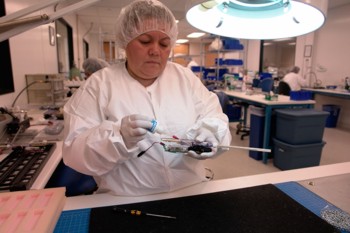Sanarus Medical Cryoablation Treatment Targets Breast Cancer
Sanarus Medical Cryoablation Treatment Targets Breast Cancer

Technology Used to Treat Benign Tumors Now Being Studied for New Uses
Sanarus Medical has just crossed a significant threshold. The cryoablation technology pioneered by the Hacienda company for benign breast disease is about to enter a National Cancer Institute-funded clinical trial for treatment of Invasive Ductal Breast Cancer (IDC).
"Cryoablation is a minimally invasive, non-surgical procedure that uses extreme cold to destroy tumors," points out Sanarus vice president of marketing Danielle Kent. In 2002, the company introduced its first treatment device, the Sanarus Visica System, after receiving initial FDA market clearance for a broad range of applications, including cryoablation of non-cancerous tumors (also known as fibroadenomas).
As a non-surgical option, the Visica System has several advantages. Notably, it can be performed in the physician's office, a marked improvement in patient comfort. "This procedure, which usually takes less than 20 minutes, involves placing a small needle into the center of the fibroadenoma using ultrasound guidance and subsequently freezing and killing the tumor," Kent explains. With such a small entry point, cryoablation is both well-tolerated and appreciated by patients, delivering "excellent cosmetic results" without scarring or changes in the shape or size of the breast. In addition, its safety and efficacy have been well established in over 2,000 fibroadenoma treatments to date.
To get to the next step - applying the Visica treatment to malignant breast tumors - further imaging tools have been necessary. The chief hurdle, or "gating factor," has been the ability to non-invasively confirm the success of the ablation-in other words, that the target area has become completely devoid of any undesirable tissue. Advances in imaging technology, specifically breast magnetic resonance imaging (MRI), may now make this possible. With its next-generation product, the Visica 2 Treatment System, Sanarus incorporates breast MRI into the overall cryoablation process, first to accurately determine the extent of the tumor before the procedure, and then to verify complete destruction of the target afterward.
"Cryoablation coupled with MRI confirmation in selected early breast cancers may offer the same therapeutic benefit of lumpectomy with less morbidity, improved cosmetic results, and less cost," Kent observes.
A recent pilot study of 20 patients at two sites - the Hoag Breast Care Center in Newport Beach, Calif., and Dartmouth Hitchcock Medical Center in Lebanon, N.H. - confirmed the effectiveness of the ultrasound-guided Visica 2 cryoablation in completely eradicating small, unifocal, malignant breast tumors. In January 2009, the American College of Surgeons Oncology Group (ACOSOG) will start enrolling 100 patients from 20 clinical sites in the Phase II Trial, using the same Visica 2, ultrasound, and MRI technology combination to evaluate post-cryoablation efficacy.
In August 2008 National Instruments named the Visica 2 Treatment System the Humanitarian Application of the Year as part of its annual NIWeek conference in Austin, Texas.
Having outgrown two previous Hacienda locations, Sanarus Medical moved to its current headquarters, at 4696 Willow Road, in December 2004. The 18,300 square foot facility includes a controlled manufacturing environment. The venture-funded company has approximately 45 employees locally and 13 sales representatives in offices around the country. For more information, visit www.sanarus.com.
Photo: Sanarus personnel assemble the Visica system in an on-site lab in their Hacienda offices.
Also in this issue...
- Sanarus Medical Cryoablation Treatment Targets Breast Cancer
- Pacific Coast Title Prepares for Housing Upturn
- Business Bits
- Executive Profile: Robin Trembath, Trembath, Deichler & Hermanson
- Raisin Business is Far From Drying Up
- NCAL Computer Source Combines Service and Technology
- Hacienda Sees Significant Construction, Leasing in 2008: Oracle, Roche Lead the Way
- Toastmasters Imparts Both Communications and Leadership Skills
- FarmShares Encourages Healthy 'Locavore' Eating
- Secret - and Published - Scribes Find Support at Tri-Valley Writers Club
- Hacienda Companies Are Making A Difference!
- Hacienda Index
- Calendar




